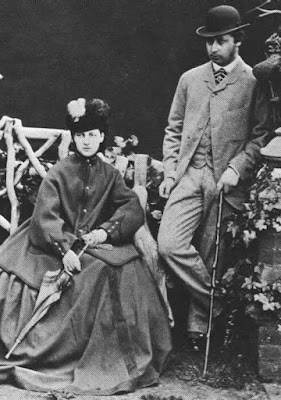Princess Alexandra was born on December 1, 1844, the oldest daughter of Christian IX of Denmark and Louise of Hesse-Kassel.
Alexandra was born at the Yellow Palace, an 18th-century town house at 18 Amaliegade, right next to the Amalienborg Palace complex in Copenhagen.
Occasionally, Hans Christian Andersen was invited to call and tell "Alix", as her immediate family knew her, and her siblings stories before bedtime.
Alexandra married Albert Edward, Prince of Wales, at St Georges Chapel, Windsor on March 10, 1863.
An 1863 exhibition of their wedding presents at the Victoria and Albert Museum attracted an average of 13,500 visitors a day during it’s 17-day run.
Alexandra bore Edward six children, three sons Albert Duke of Clarence, a weak minded fool who died in 1892 before he could become King of England, George who succeeded his father on the throne and the third son died in infancy. Their three daughters were the Louise, Princess Royal and Duchess of Fife, Princess Victoria and Princess Maud, later the Queen of Norway.
Alexandra was born at the Yellow Palace, an 18th-century town house at 18 Amaliegade, right next to the Amalienborg Palace complex in Copenhagen.
Occasionally, Hans Christian Andersen was invited to call and tell "Alix", as her immediate family knew her, and her siblings stories before bedtime.
Alexandra married Albert Edward, Prince of Wales, at St Georges Chapel, Windsor on March 10, 1863.
An 1863 exhibition of their wedding presents at the Victoria and Albert Museum attracted an average of 13,500 visitors a day during it’s 17-day run.
 |
| Princess Alexandra of Denmark and the Prince of Wales, 1863 |
Alexandra bore Edward six children, three sons Albert Duke of Clarence, a weak minded fool who died in 1892 before he could become King of England, George who succeeded his father on the throne and the third son died in infancy. Their three daughters were the Louise, Princess Royal and Duchess of Fife, Princess Victoria and Princess Maud, later the Queen of Norway.
Alexandra suffered from rheumatic fever during the birth of Louise, Princess Royal on February 10, 1867. The illness combined with labor almost killed Alexandra, and although she recovered, the rheumatic fever left her with a permanent pronounced limp. Her gait was later emulated by young women to whom she was a style and fashion icon. They went around fake limping, dubbed the "Alexandra Limp." Shopkeepers at the time sold pairs of shoes with one high heel and one low.
Alexandra's style of dress and bearing were copied by fashion-conscious women. She launched the high dog collar of pearls held in place by diamond bars and also the curled fringe. In addition she introduced the first practical day coat suited to the English weather.
Alexandra had a pet goat. It had originally been destined to be slaughtered for dinner on a cruise but it slipped its tether and put its head on her lap so she adopted it.
She was Princess of Wales from 1863 to 1901, the longest anyone has ever held that title.
In 1910, Alexandra became the first queen consort to visit the British House of Commons during a debate. For two hours she sat in the Ladies' Gallery overlooking the chamber while the Parliament Bill, a bill to reform the role of the House of Lords, was debated.
On Edward's death, Alexandra moved out of Buckingham Palace to Marlborough House and received a salary of £70,000 PA.
 |
| Queen Alexandra, 1923 |
Alexandria died on November 20, 1925 at Sandringham after suffering a heart attack, and was buried in an elaborate tomb next to her husband in St George's Chapel, Windsor Castle.
Source Funk & Wagnells
No comments:
Post a Comment